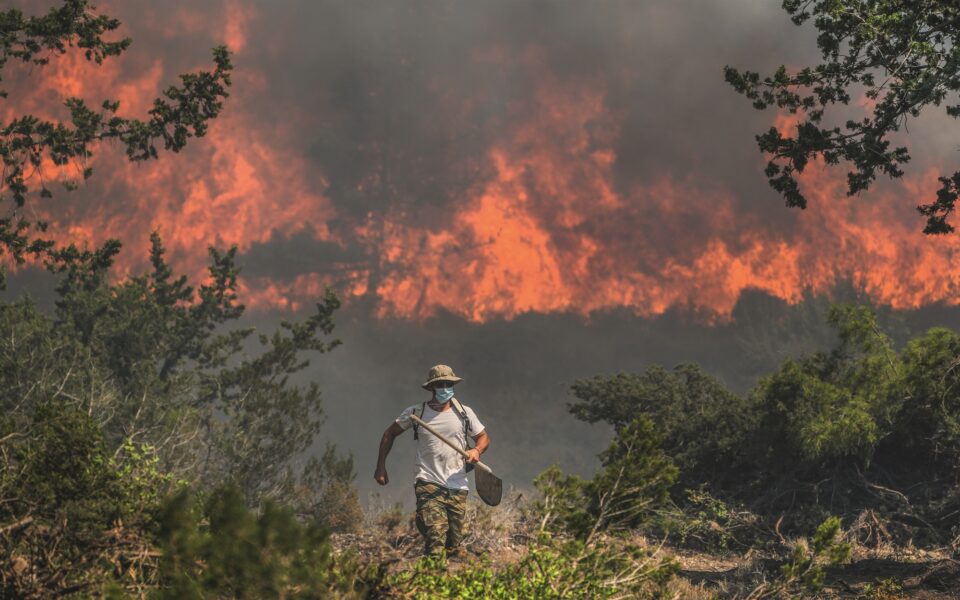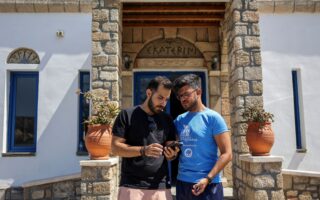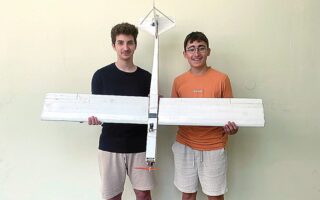Chasing a fire that won’t give up
Rhodes residents organizing their own patrols to spot flare-ups before they get out of control

A cloud of smoke rising above the blackened hillside surrounding the village of Vati marks the spot of the most recent flare-up on Rhodes of a wildfire that has been rampaging across the southeastern Aegean island for more than a week. More threats loom, like the plumes of smoke coming from already scorched tracts or the smoking trunk of an incinerated tree close to a cluster of pine trees that escaped the passage of the blaze. On the winding road leading to the village of Laerma, a firetruck fills up from a water tanker before returning to the job of dousing these small residual fires before they’re stoked by the next gust of wind.
Flare-ups that have gotten away, however, mainly in the southeast of the island, sent the wildfire back toward villages that had already come under threat, as was the case on Tuesday with Gennadi, where residents who had made their way back to their homes were ordered to evacuate again. Firefighters and residents appear locked in an interminable game of chase with a blaze that keeps running circles around them, rushing down hillsides down to the coast and back up again.
‘We’d put a blaze out, move forward a meter and it would reignite right behind us, so we’d go back at it with hoes and anything else we could get our hands on’
It’s Tuesday morning and on the road leading to Vati, in the southern hinterland, a young shepherd looks at the fire high up in the hills, where it can only be tackled with water-dropping aircraft. He got home at 3 a.m. earlier that day after spending most of the night helping firemen and other locals prevent yet another flare-up that would threaten his village, Profilia. The team comprised four firetrucks, 10 pickup trucks carrying water tanks and 30 volunteers who were helping the firefighters and showing them the lay of the land and the best routes for approaching the forest fire, while still having an escape route. “We’d put a blaze out, move forward a meter and it would reignite right behind us, so we’d go back at it with hoes and anything else we could get our hands on,” he tells Kathimerini, declining to be named.
As we speak, a new blaze flares up high on a hill, away from the main front, possibly sparked by embers transported by strong winds. Another local comments as he watches the flames rise, “Don’t tell me that’s not a fire that was started deliberately.” Three Canadairs dump water on the blaze in succession, but the flames rise again. Four smaller Air Tractors take over, then another, getting as close to the base of the fire as possible. As the smoke thickens, a pickup truck comes up the main road carrying 10 volunteers wearing bandanas across their mouths and noses and carrying hoes and shovels. More will come in cars and on motorbikes, ready to help in any way they can, holding the hoses for the firefighters or even beating down the flames with branches.
Locals have also taken to social media to organize patrols in areas where fires have been extinguished and also at night in order to spot flareups. They shovel dirt over every ember or wisp of smoke they see.
In Laerma, a village where the fire destroyed farm stores and equipment, residents were waiting on Tuesday for a damage assessment team to arrive. A local tells Kathimerini how the community helped the firefighters keep the village safe when it was surrounded by flames. “We watched the fire get closer for three days. It was July 18, before the winds got strong. After that, it was too late,” he says. “I doused my house with water when the flames started reaching our gardens. It was dramatic. We went to the village soccer stadium and stayed there until daybreak, when it was safe again,” adds the man, who works with his wife at a hotel in Kiotari which was closed by the fire. Both are worried about their jobs, he says.
A part of this same area had been badly damaged by a fire in 2008. “The new forest has been destroyed before it even had a chance to produce pine cones and drop new seeds,” says another resident of Laerma. “What’s going to happen to this forest?”





